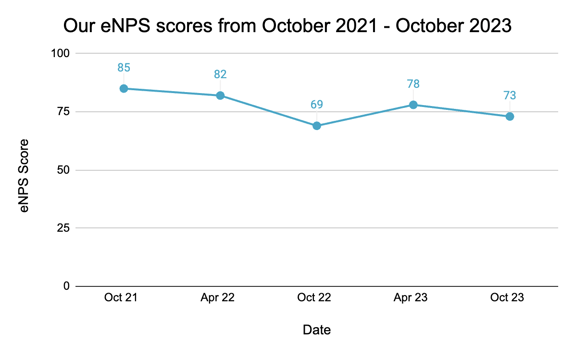Creating a healthy work environment is not just the right thing to do; it's essential for fostering productivity, creativity, and overall well-being. At its core, a healthy work environment is one where motivation is high, productivity soars and job satisfaction becomes the norm, not the exception.
HR practitioners will typically be well acquainted with Maslow’s Hierarchy of needs, Herzberg's Two-factor theory, or Theory X and Theory Y as created by McGregor. In the same family of theories on work motivation, we know the Expectancy Theory by Victor Vroom. Expectancy Theory posits that an individual's motivation is directly linked to their expected outcomes, suggesting that people are motivated to work harder if they believe their efforts will lead to desirable results. It asserts that for employees to be genuinely motivated, there must be a visible and believable link between effort, performance, and reward.
" The expectancy theory has three components:
- Expectancy: effort → performance (E→P)
- Instrumentality: performance → outcome (P→O)
- Valence: V(R) outcome → reward "
Retrieved from Wikipedia on March 14th, 2024.
Although the theory has received its share of critique, and Vroom concurs that more research is necessary to refine his concept, we've identified some compelling aspects that justify (a rather flexible) adaptation in our workplace.
Implementing Vroom's Expectancy Theory involves understanding and applying the three core components: expectancy, instrumentality, and valence. By addressing these components, we can create a motivating environment that encourages employees to perform at their best. I'm happy to share a few practices.
1. Expectancy: Setting Clear Goals and Expectations
Expectancy refers to the confidence that one's efforts will lead to achieving specific performance goals. To bolster this confidence, we focus on transparent communication and skill development.
Transparent Communication
As consultants, we work by default on different projects, most of our time we spend working with our clients, not necessarily with our Inuits-colleagues. Keeping everyone aligned on organizational objectives and sharing common goals can become challenging as a consequence. Through monthly AMA’s (Ask Me Anything, inspired by Reddits r/IAmA) on all things Inuits, regular check-ins, supplemented with ad hoc meetings, after hours sports and team-events twice a year, we installed a culture where our team members are encouraged to keep a close connection with the organization they represent, where they get the information they need and feel empowered to ask what they want to know.
.jpg?width=575&height=384&name=regular-feedback%20(2).jpg)
Skill Development
Training and skill development is a difficult point in many organizations. Big corporations will typically have a dedicated department, creating career paths for every function or function-group. In SMEs (small and medium-sized enterprises) , things typically get more complicated. At Inuits we use the feedback from our clients, ideally improved with clarity on upcoming objectives, combine these with input from the regular check-ins with our consultants, and specific wishes to create a personalized approach.
2. Instrumentality: Linking Performance to Rewards
Instrumentality refers to the conviction that fulfilling a performance expectation will lead to a reward. Rewards can come in many forms, we concentrate on feedback and performance-based.
Regular Feedback
Regular and relevant feedback is often a pain in (consultancy) organizations. While consultants' formal reporting structures are within the parent company, their daily tasks are performed for the client, leading to challenges in gathering accurate information for effective performance evaluations. To address this, we've been trialing the introduction of Functional Lead roles—senior team members embedded within teams acting as intermediaries between the consultant and client to guide follow-ups more effectively.
Performance-based Rewards
The IT consultancy sector is competitive, and professionals aware of their high demand in the market find themselves in a strong position to negotiate favorable terms. Generally, these terms center predominantly around a fixed salary. Then, as mastery increases, so does productivity, and salary-increases and / or promotions as a consequence.

3. Valence: Ensuring the Rewards are Valued
Valence refers to the importance an individual assigns to the potential rewards of an outcome. We work on different tracks.
Personalized Rewards
Tailoring incentives, such as through a cafeteria plan, must consider each country's unique constraints and opportunities; a one-size-fits-all approach doesn't work. In high-tax countries, businesses often offer perks like vouchers or company cars to optimize tax benefits. However, in Poland, with its labor tax rate around the OECD average, we favor giving employees the freedom to decide how to use their earnings, avoiding an excessive reliance on fringe benefits. We are well known however, for offering flexible working hours, or to enable work from home for optimal work-life balance.

Recognition Programs
Should public recognition become a formal practice? Likely, and we recommend incorporating it into stand-ups, demo's or other scrum ceremonies where appropriate. However, does this apply universally? Not quite, as we must respect our customers' traditions and may not always be able to enforce our policies there. Alternative methods haven't proven successful for us. For instance, dedicated kudos channels often become platforms for recognizing those who work overtime, and naming individuals in general team meetings risks missing some achievements. This issue is among our toughest challenges, and we're keen to learn about your team's solutions. Please share your strategies in the comments.
The results, how do we score?
How to measure job satisfaction in an organization? Several metrics can be used, from performance metrics, over asking directly in one-on-one meetings or exit-interviews to turnover rates. While we do take into account the other metrics, we decided to use the eNPS. Powered by our HR platform Bamboo, we have been tracking over the last years and are proud to share the results in fig 1.

Source: Visualisation based on data gathered by Bamboo HR platform (2024).
Industry benchmarks for eNPS scores differ significantly; Perceptyx reports that the IT industry typically achieves an average score of +28. However, our scores surpass this average considerably. Can we improve? Absolutely, and it's crucial to recognize that eNPS is just one piece of the puzzle. High satisfaction may stem from factors not covered in our discussion. As always, correlation does not equate to causation.
Interested to learn more about building teams and how we can augment your business? Feel free to book an online meeting.